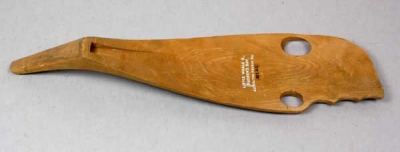Spear thrower (1888.43.2)
 CanadaSpear thrower from Canada, Americas. Collected by Walton Haydon. Given to the Museum in 1888.
CanadaSpear thrower from Canada, Americas. Collected by Walton Haydon. Given to the Museum in 1888.
This unusual-looking object is a spear thrower (also generally known as an 'atlatl'). Although not a weapon it itself, the spear thrower is a device used to increase the speed, distance or force of a spear when thrown.
This particular example is made of lightweight wood and has an elongated shape, together with ergonomic features to accommodate the human hand. It was collected at Little Whale River on the eastern side of Hudson's Bay, Canada and may be Innu in origin. Innu communities continue to live in the area today. The collector, Dr. Walton Haydon, worked as a surgeon and clerk for the Hudson's Bay Company (HBC) from 1878 to 1883 where he was stationed at Moose Factory in James Bay.
Form and Function
The spear thrower has a documented history of over 25,000 years and has been found on every continent except Antarctica. It has been suggested that it traveled to North America about 12,000 years ago with migratory hunters from Asia. Certainly the spear thrower developed in, or diffused into, those societies where serious hunting and fighting were done with spears.
In historic literature, the spear thrower has attained a reputation for being clumsy and inefficient. However, when designed and used in the right way, it ensures the spear hits its target with more energy and with similar accuracy to the bow. It has long been asserted that the main advantage gained from using a spear thrower was the ability to launch the spear a greater distance, achieved by the leverage effect due to the effective lengthening of the arm. However, experimental research has revealed that the two main advantages are in fact greater power (up to 60% extra force) and greater accuracy, and archaeologists have shown that neither is the exclusive outcome of improved leverage (although this is a factor). Rather, increased power really results from prolonged contact with the hand during acceleration. Greater accuracy in the throw is possible for the same reason: the thrower is in contact with his missile for longer and can therefore correct his throw during it. Moreover, grip and control are generally much improved.
This is a right-handed spear thrower, as shown by the shape of the bevel on the thumb-hole, the larger of the two holes. The other hole is for the forefinger and the grip is for the remaining three fingers. It would be held behind the right shoulder with the wrist bent slightly back so that the device was more or less parallel to the ground. The spear butt would then fit into the notch at the opposite end. The thumb-hole not only gives the thrower great leverage, but allows him to support the spear-shaft with his thumb-tip through the body of the tool itself. The spear would then be ready to be thrown. Devices like this could also be used to launch arrows in a similar fashion. It is worth noting that this is a 'female' spear-thrower; that is, the spear butt fits into the socket, rather than vice versa. Consequently, no modification needs to be made to a spear used with this spear-thrower.
This highly functionalised form of spear thrower illustrates the importance of hunting success among the Innu people in their extreme, marginal environment in northern Quebec. The Innu are an Algonquian-speaking people, formerly known as the Naskapi-Montagnais. They were traditionally nomadic, tent-dwelling hunter-gatherers, who exploited fish stocks in the river, and the large migratory herds of caribou as well as other animals such as beaver. The harshness of the environment meant that men could die from exposure on hunting trips, and their families starve as a result. The sparseness of game demanded that the Innu maintain a low population density across the region, and so social groups were small, numbering one or two tents of immediate family. In general, the Innu had little interest in status rivalry, although men admired and respected each other for their skill in the hunt. In such circumstances, the advantages gained by the hunter over his prey could make the difference between life and death for several people.





